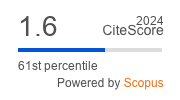Format of Manuscript
Any earlier submission form converted to pdf is allowable by editor but the final paper if accepted must be formatted using special LaTeX template which available in the MJMS’s journal website. We recommend all authors should use the LaTeX template for the first submission.
A maximum of eight (8) keywords should be indicated below the abstract to describe the contents of the manuscript. Leave a blank line between each paragraph and between each entry in the list of bibliographic references. Tables should preferably be placed in the same electronic file as the text. Authors should consult a recent issue of the Journal for table layout.
Every page of the manuscript, including the title page, references, tables, etc. should be numbered. However, no reference should be made to page numbers in the text; if necessary, one may refer to sections. We recommend that authors prepare the manuscript in LaTeX file (Download here).
- Manuscripts should be organized in the following order
- Title of your article. The maximum amount of words for title is 26 words. No notations or symbols should be used in the title.
- Author(s) and corresponding author information. This page should contain name of all the authors, affiliations and corresponding author's name. This journal is recognising the first author name as the corresponding author for the article.
- Example:
1Hishamuddin Zainuddin and 2Chan Kar Tim
1Institute for Mathematical Research, Universiti Putra Malaysia, Malaysia
2Department of Physics, Faculty of Science, Universiti Putra Malaysia, Malaysia
- Example:
- Abstract (the abstract should be less than 250 words). Keywords must also be provided on this page (Not more than eight keywords in alphabetical order).
- The article should begin with the Introduction of your article.
- Text
- Research / Original Papers should be prepared with the headings Introduction, Materials and Methods, Results and Discussion, Conclusions in this order.
- Tables
- All tables should be prepared in a form consistent with recent issues of MJMS and should be numbered consecutively with Arabic numerals. The explanatory material should be given in the table legends and footnotes.
- Equations and Formulae
- All equations and formulae must be set up clearly and should be typed using any tool for mathematical writing but should follow to the rules of grammar of mathematics writing. Routine structural formulae can be typeset and need not be submitted as figures. Numbers identifying equations should be in brackets and placed on the right margin of the text.
- Figures & Photographs
- Submit an original figure or photograph. Illustration including diagrams and graphs are to be referred to in the text as ‘figures’ and photographs as ‘plates’ and numbered consecutively in Arabic numerals. All photographs (glossy black and white prints) should be supplied with appropriate scales. Illustrations should be in the form of the best print quality, in coloured and resolution as the journal only available in the e-print form.
- References in Text
- Literature citations in the text should be made by name(s) of an author(s) and year. For references with more than two authors, the name of the first author followed by 'et al.' should be used.
- In case of citing an author(s) who has published more than one paper in the same year, the papers should be distinguished by the addition of a small letter as shown above, e.g. Hishamuddin (2000a); Hishamuddin (2000b).
- Unpublished data and personal communications should not be cited as literature citations but given in the text in parentheses. 'In press' articles that have been accepted for publication may be cited in References. Include in the citation the journal in which the 'in press' article will appear and the publication date, if a date is available.
- Avoid any source or literature which has no peer reviewing processes to be referred in the article.
- The maximum self-citation (author and co-author) allowed is up to THREE references only.
- Literature citations in the text should be made by name(s) of an author(s) and year. For references with more than two authors, the name of the first author followed by 'et al.' should be used.
- End References
- References should be listed in alphabetical order, by the authors' last names. For the same author, or for the same set of authors, references should be arranged chronologically. If there is more than one publication in the same year for the same author(s), the letters 'a', 'b', etc., should be added to the year.
- When the authors are more than 11, list 5 authors and then et al.
- Do not use indentations in typing References. Use one line of space to separate each reference. The name of the journal should be written in full. For example:
- Abdullah, A. R. (1991). The four-point Explicit Decoupled Group (EDG) method: A fast Poisson solver, International Journal of Computer Mathematics, 38: 61-70.
- Akhir, M. K. M., Othman, M. Z., Majid, A., Suleiman, M. and Sulaiman, J. (2012). Four Point Explicit Decoupled Group Iterative Method Applied to Two-Dimensional Helmholtz Equation. International Journal of Mathematical Analysis, 6: 963–97.
- The references format and style from the given LaTeX template output should be followed.
- Examples of other reference citations:
- Book: Delves, L. M. and Mohamed, J. L. (1985). Computational Methods for Integral Equations. London: Cambridge University Press.
- Chapter in Book: Jost, J and Yau, S. T. (1991). Harmonic maps and group representations. In B. Lawson and K. Tenenbelt (Ed.), Differential geometry and minimal submanifolds (p. 241-260). England: Longman Scientific.
- Index Proceeding: Rowling, L. (1993, September). Schools and grief: How does Australia compare to the United States. In Wandarna coowar: Hidden grief. Paper presented at the Proceedings of the 8th National Conference of the National Association for Loss and Grief (Australia), Yeppoon, Queensland (pp. 196-201). Turramurra, NSW: National Association for Loss and Grief.
- Appendix
- Author is advised not to have any appendix. Try to incorporate all findings and outputs in the text section.









